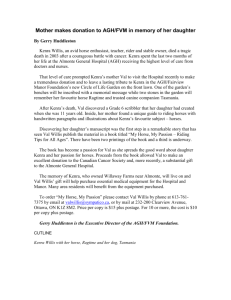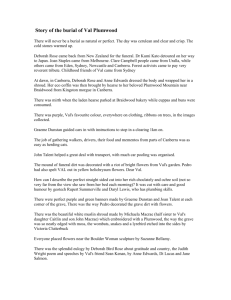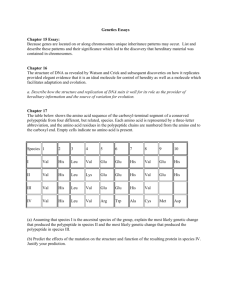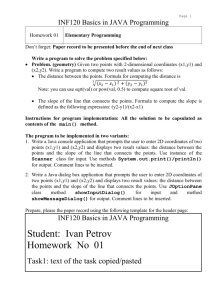lt23990-sup-0001-suppinfo
advertisement
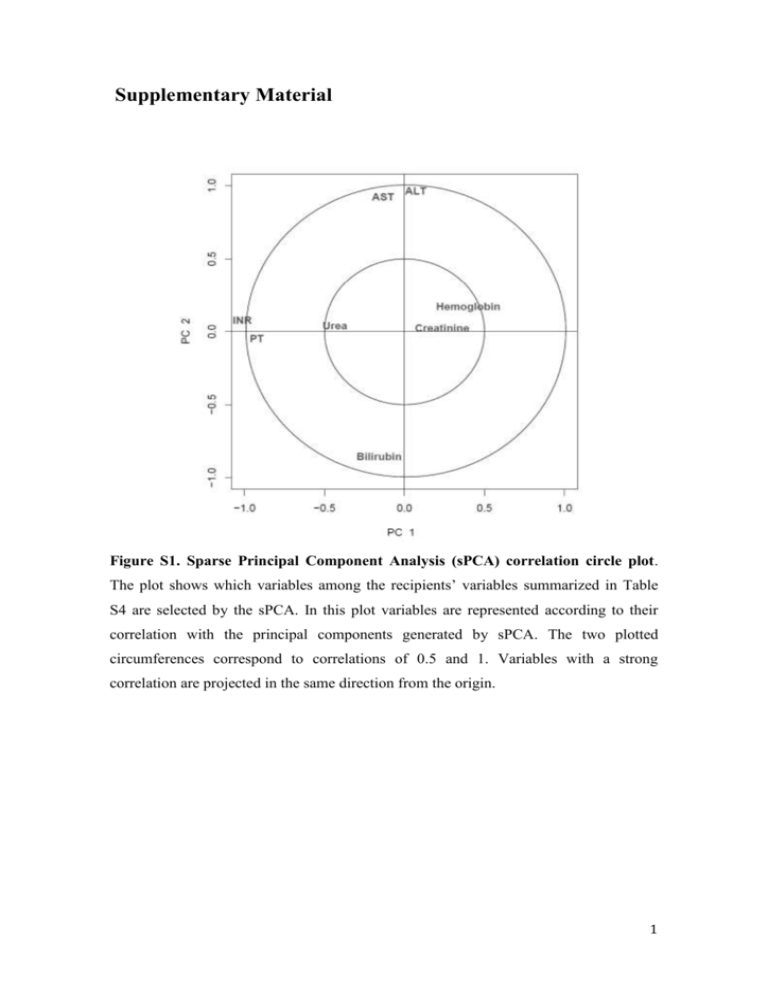
Supplementary Material Figure S1. Sparse Principal Component Analysis (sPCA) correlation circle plot. The plot shows which variables among the recipients’ variables summarized in Table S4 are selected by the sPCA. In this plot variables are represented according to their correlation with the principal components generated by sPCA. The two plotted circumferences correspond to correlations of 0.5 and 1. Variables with a strong correlation are projected in the same direction from the origin. 1 Figure S2. Correlation analysis between the recipient’s clinical variables selected by sPCA. 2 Figure S3. Estimated probabilities of PNF derived from the logistic regression analysis in both the model building and the external validation cohorts. PNF: primary nonfunction. 3 Variable Age (years) Gender (male/female) Gender mismatch No Male(D) → Female (R) Female(D) → Male (R) BMI(kg/m2) Cause of death CVA Head trauma Anoxia Brain tumour Others ICU Stay (days) Hypotension ( no/yes) Heart arrest (no/yes) Inotropic drugs No <2 ≥2 Na (mEq/L) Steatosis No Mild (<30%) Moderate (30-59%) Mean 54.5 509/330 499 116 224 26.5 567 205 43 8 16 3.48 487 /352 710/129 541 218 80 149 SD 17.6 Min. Val. 12 Max. Val. 86 4 13.8 49.4 3 1 45 120 188 10.6 678 143 18 Table S1. Donor Information Summary. Continuous variables are described as the mean, categorical variables are expressed as an absolute number. BMI: body mass index; CVA: cerebral vascular accident; D: donor; ICU: Intensive Care Unit; Min. Val: minimum value; Max. Val: maximum value; Na: sodium; R: recipient, SD: standard deviation minimum value. 4 Variables Surgery length (min) CIT (min) WIT (min) Arterial anastomosis delay (min) Cell saver (ml) RBC (units) FFP (units) Graft wash Saline Blood Saline + Blood Post-reperfusion syndrome (no/yes) T-tube (no/yes) Relaparotomy for bleeding (no/yes) Mean 254 311 44 43 SD 48 156 15 19 710 3 2.5 698 2.8 1.7 Min. Val. 100 22 15 10 0 0 0 Max. Val. 545 850 135 180 10000 33 14 83 289 467 717/122 323 /516 767/72 Table S2. Surgery Information Summary. Continuous variables are described as the mean, categorical variables are expressed as an absolute number. CIT: cold ischemia time; FFP: fresh frozen plasma; Min. Val: minimum value; Max. Val: maximum value; RBC: red blood cells; SD: standard deviation; WIT: warm ischemia time. 5 Variable Age (years) Gender (male/female) BMI (kg/m2) Primary Diagnosis Viral Alcohol Cholestatic Tumor Viral + tumour Alcohol + viral Alcohol + tumour Alcohol + viral + tumour Others Tumour (HCC/Neuroendocrine) MELD score Child-Pugh store A B C ICU stay (days) Hospital stay (days) Post-Tx RBC Transfusion (yes/not) Post-Tx FFP Transfusion (yes/not) CMV (positive/negative) CMV mismatch No D (-)→R(+) D(+)→R(-) HBcAb (+/-) Mean 54.14 633/206 27 SD 9 Min. Val. 17 Max. Val. 70 4.4 15.6 45.4 16.7 7.6 6 57 152 284 403 6 23 5 21 1 1 115 240 195 184 25 19 147 87 56 55 71 267/10 681/158 662/177 698/141 590 156 93 403/436 Table S3. Recipient Information Summary in 839 OLTs. Continuous variables are described as the mean, categorical variables are expressed as an absolute number. Continuous variables are described as mean, standard deviation (SD), minimum value (Min. Val) and maximum value (Max. Val); categorical variables are expressed as an absolute number. From the 23 patients who underwent a retransplantation, 13 had the first transplant before the studied period. D: donor; BMI: body mass index; CMV: cytomegalovirus; FFP: fresh frozen plasma; HBcAb: hepatitis B core antibodies; HCC: hepatocellular carcinoma; ICU: intensive care unit; MELD: model for end-stage liver disease; Min. Val: minimum value; Max. Val: maximum value; Post-OLT: postorthotopic liver transplant; R: recipient; RBC: red blood cells; SD: standard deviation minimum value. 6 Biochemical test Full blood cell count Coagulation parameters Albumin (g/dl) Haematocrit (%) APTT (s) ALT/GPT (U/L) *, ** Haemoglobin (g/dl) Fibrinogen (mg/dl) AST/GOT (U/L) * Leukocytes (103/μl) INR *, ** Platelets (103/μl) Prothrombin time (s)* Bilirubin (mg/dl) *, ** Creatinine (mg/dl) Glucose (mg/dl) Ions Total proteins (g/dl) Urea (mg/dl) Table S4. Summary of recipients’ clinical variables candidates to model EAD. *, parameter frequently used to define EAD, see Table 1; **, parameters used in our score. ALT: aspartate alanine transferase; AST: aspartate alanine transferase; APTT: activated partial thromboplastin time; INR: international normalised ratio, LDH: lactate dehydrogenase. 7 Model building cohort Follow-up (months) Hazard ratio Confidence Interval (95%) p-value 3 1.19 1.01; 1.41 0.042 6 1.23 1.05; 1.44 0.009 12 1.21 1.05; 1.41 0.009 External validation cohort Follow-up (months) Hazard ratio Confidence Interval (95%) p-value 3 2.43 1.58; 3.73 <0.001 6 2.24 1.52; 3.31 <0.001 12 1.95 1.38; 2.75 <0.001 Table S5. Survival analysis by Cox regression: for 3-, 6- and 12-month follow-ups using MEAF score as continuous predictor in both the model building and the external validation cohort. 8 Variable Model averaged importance Age 0.96 Hepatic steatosis 0.92 ICU stay 0.83 Vasoactive drugs 0.49 Sodium levels 0.35 Heart arrest 0.05 Rh 0.05 BMI 0.04 Hypotension 0.03 Cause of death 0.01 Table S6. Importance of Donor’s parameters estimated by model averaging. BMI: body mass index; ICU: Intensive Care Unit. 9 Variable Model averaged importance Cold ischemia time 1.00 Postreperfusion syndrome 0.95 Warm ischemia time 0.88 RBC units 0.69 FFP units 0.58 Relaparatomy 0.29 Operation duration 0.18 T-tube 0.14 Cell saver 0.09 Table S7. Importance of Surgery’s parameters estimated by model averaging. FFP: fresh frozen plasma; RBC: red blood cells. Post-reperfusion syndrome is defined as hypotension (mean arterial blood pressure 30% lower than the value immediately at the end of a hepatic stage, lasting for more than 1minute within 5 minutes) or asystole after unclamping. 10 Variable Model averaged importance MELD 1.00 BMI 1.00 Child Pugh 1.00 FFP 0.82 ICU stay 0.82 Hospital stay 0.81 Age 0.30 Gender 0.13 RBC 0.12 Retransplantation 0.03 Renal function 0.03 SBP 0.03 UGIB 0.03 Encephalopathy 0.02 Ascites 0.01 HCC 0.01 CMV 0.00 Table S8. Importance of Recipient’s parameters estimated by model averaging. BMI: body mass index; CMV: citomegalovirus; FFP: fresh frozen plasma; HCC: heaptocellular carcinoma; ICU: intensive care unit; MELD: model for end stage liver disease; RBC: red blood cells; SBP: spontaneous bacterial peritonitis; UGIB: upper gastrointestinal bleeding. 11

